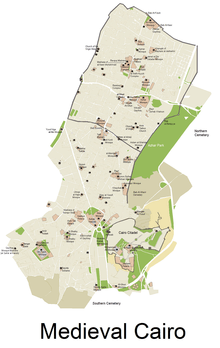Mausoleum of Al-Saleh Nagm Al-Din Ayyub
Mausoleum of Al-Saleh Nagm Al-Din Ayyub (Arabic: مدرسة وقبة نجم الدين أيوب, romanized: Madrasa wa Qubbat Nagm Al-Din Ayyub, lit. 'Madrasa and dome of Nagm Al-Din Ayyub')[1] is a complex of mausoleum and madrasa in the Islamic Cairo quarter of Cairo, Egypt. The complex was constructed by the Ayyub sultan As-Salih Ayyub in 1243. It is situated at the Muizz Street in front of the Qalawun complex, forming a part of the most well known area of the Islamic Cairo.[2]
Description

The building was constructed on the western part of the former Fatimid castle. The madrasa conducted the education for the four Islamic schools of jurisprudence. It is considered the first madrasa in Egypt which provided education for all four maddhabs. In 1250, a mausoleum for the Sultan As-Salih Ayyub was erected by his wife. This had created an Ayyub building complex in the heart of the Fatimid Cairo, and the complex was created in the way overlooking the street, and consisted a place which resembled kasbah for the king. This new approach was followed by the later sultans, the best known example is Qalawun complex. However, the complex of Al-Saleh only included a madrasa and a mausoleum, before the end of the Ayyub dynasty.[2][3]
Since the 11th century, the Islamic dynasties in Egypt had contributed to the spread and intellectual development of Islam through construction of madrasas which provided higher education and training for Sunni faqih. Historical accounts such as the map of al-Maqrizi show that there were 24 madrasas in the Ayyub Cairo. However, all of these madrasas except the Madrasa of Al-Saleh and Madrasa al-Kamil were destroyed. Even the majority of the Madrasa of Al-Saleh were destroyed except a part of western iwan, which is the only remaining part of original building.[3]
References
| Wikimedia Commons has media related to Mausoleum of Al-Saleh Nagm Al-Din Ayyub. |
- archnet. Retrieved January 29, 2018.
- مدرسة وقبة نجم الدين أيوب. Official website of Cairo. Retrieved January 29, 2018.
- مدرسة الصالح نجم الدين أيوب. Museum with no Frontiers. Retrieved January 29, 2018.

